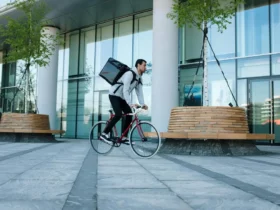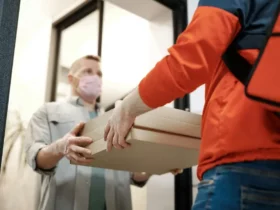Ever found yourself pondering whether to tip your Instacart driver? You’re not alone. Just like when you slide into the backseat of a rideshare or hear the doorbell ring with your pizza delivery, tipping is a part of the Instacart experience. But how much should you tip, and what does it mean for the person on the other side of your grocery order?
I remember my first time using Instacart, unsure if the etiquette was like dining out or more akin to a quick coffee shop interaction. Instacart itself suggests a 5% tip, yet I’ve learned that tipping generously not only reflects the quality of service but also contributes significantly to the driver’s earnings. After all, a whopping 100% of the tip goes directly to the person who carefully selects your ripe avocados and ensures your eggs make it home uncracked.
Navigating the World of Instacart Tipping: A Comprehensive Guide
When you’re using Instacart, tipping is optional, but it’s a powerful way to show your shopper how much you appreciate their hard work. Remember, these shoppers are out there navigating store aisles, standing in checkout lines, and sometimes braving inclement weather just to bring your groceries to your doorstep. That’s why I’m a big advocate of tipping generously whenever possible.
Let’s break down how you can add a tip. During checkout, you have two main options – the website or the in-app feature. If you’re using the website, simply head over to the “Say thanks with a tip” page right before placing your order. Pick an amount that reflects your gratitude and your budget, then finalize your order. If you’re more of an app person like me, you tap “Go to Checkout,” scroll to “Delivery Tip,” hit “Change,” set your desired tip, and save it. Easy, right?
Instacart suggests a default tip of 5% of your total order, but you’re not limited to that. Feel free to adjust the amount based on the service you received. You can change your tip for up to 14 days after delivery – increase it if you’re particularly impressed, or decrease (but do so cautiously) within 2 hours post-delivery if there were issues.
And what about how much to tip? Well, there are suggestions, but honestly, it’s up to you. I tend to follow this rule of thumb – if I’m wow-ed by the service, I show it with a bigger tip. It’s worth noting that 100% of your tip goes straight to the shopper.
How to Tip on Instacart
Tipping During Checkout
When I’m wrapping up my Instacart order, I’ve noticed that tipping is as straightforward as picking my groceries. Right at checkout, Instacart neatly suggests a default tip that’s typically 5% of my total. If I’m on their website, I spot this option on the “Say thanks with a tip” page. Here’s the breakdown for adding a tip online:
- At checkout, I proceed to the Say Thanks with a tip page.
- I select how much I want to tip, and then I just click Place order.
If I’m using the app, which I often do on the go, tipping is just a few taps away:
- I tap Go to Checkout and scroll to Delivery Tip.
- A tap on Change lets me select my desired tip amount.
- Lastly, I hit Save Tip, and my gratitude is all set to go alongside my groceries.
It’s not just about picking a number, though – I think of it as a way to recognize the hard work behind my easy shopping experience.
Modifying Tips Post-Delivery
Let’s say I want to adjust the tip after my delivery arrives – maybe the shopper went out of their way to find my favorite snacks, or they delivered amidst a downpour. Instacart’s got me covered here too. Modifying the tip is possible, and here’s how:
Increasing Tips Up to 14 Days After Delivery:
Instacart gives me plenty of time to consider a tip boost. All I need to do is:
- Click Menu and select Your Orders.
- Find the order, click on View Order Detail.
- At the top, I click on Rate Order, and then I can increase the tip as a thank you for exceptional service.
Reducing Tips Up to 2 Hours After Delivery:
Although I’ve rarely needed to, I know I can reduce the tip within two hours of delivery if something didn’t go as expected. I follow similar steps:
- From the Menu, I choose Your Orders.
- After selecting the specific order, I click on Rate and Tip.
- Here, I can adjust the tip amount and save the change.
Remember, drivers get the full amount of the tip, so it feels good knowing my extra show of appreciation goes directly to the person who made my day a little easier.
Understanding the Instacart Tipping Etiquette
The Role of Shoppers and Drivers
Instacart’s service hinges on the diligent work of two groups of people: the shoppers and the drivers. In many instances, these roles overlap; a full-service shopper also shoulders the responsibility of delivery. They roam store aisles, keenly selecting products, ensuring quality, and assembling orders with the utmost attention to customer preferences. If you’ve ever been on the receiving end of a perfectly ripe avocado or a loaf of bread with an ideal sell-by date, you know the value of a skilled shopper.
Working against the clock, they’re not on hourly wages but are paid batch by batch, making efficiency and accuracy their top priorities. Imagine navigating crowded stores, deciphering shopping lists amidst out-of-stock scenarios, and offering suitable replacements—all while on a strict time crunch. It’s a nuanced dance between personal shopper and delivery driver, culminating in the doorstep delivery of your carefully picked groceries.
Appropriate Tip Amounts
Let’s unpack the sometimes ambiguous concept of appropriate tip amounts. Instacart suggests a minimum 5% tip or the higher percentage based on your most recent order’s tip history.
So, what’s considered generous? As I mentioned earlier, tips are a voluntary but powerful expression of gratitude. They reflect how much you value the convenience and personal touch provided by your shopper. It’s not unlike tipping at a restaurant, where 15-20% is the norm for good service. For stellar service, you might tip even more. Acknowledging exceptional effort, especially under challenging circumstances like inclement weather or managing heavy and bulky items, goes a long way.
Consider the complexity of your order, too. A shopping spree involving a high item count, particularly weighty goods, or a larger distance from the store, should logically prompt a more substantial tip. It’s compensating for the extra time, effort, and care your shopper invested to meet your needs. My guideline? Start at 5% and climb from there—keeping in mind the tangibility of your appreciation through the tip you give.
H2: Special Considerations in Instacart Tipping
Tipping on Large or Complex Orders
When I’m faced with a large or complex order, I often consider how much effort the shopper had to put in. I’ve been on both ends of the spectrum—I’ve had the easy-breezy 10-item list, and I’ve also tackled the daunting 80-plus item orders that are meant to last a customer the whole month. Trust me, there’s a big difference! Here are a couple of things I look at to gauge an appropriate tip:
- Number of Items: More items typically mean more time searching the aisles and potentially dealing with out-of-stock situations.
- Special Requests: If I’ve asked for something specific, like ripe avocados or a particular cut of meat, that adds complexity.
- Handling and Packaging: Fragile items require extra care. I wouldn’t want my eggs cracked or my bread squished!
- Organization: A good shopper organizes cold items together to keep them fresh until they reach my doorstep.
For these reasons, I lean towards the generous end with my tips on large or complex orders. A solid 20% or even higher shows my shoppers that I recognize the extra work they’ve put in for my convenience.
Cash Tips vs. In-App Tips
Now let’s talk about cash versus in-app tipping. There’s something satisfying about handing over a cash tip. It’s tangible—a physical pat on the back for a job well done. I like to think of it as a bonus, a little extra ‘thank you’ on top of the tip I’ve already given through the app. When I tip in cash without adding a tip in the app, my order looks less appealing to shoppers since it shows up as a no-tip order upfront. Here are a few reasons why in-app tipping has its advantages:
- Visibility: Shoppers can see the tip before they accept the order, which might mean faster acceptance and delivery for me.
- Adjustability: If the service really blew me away, I can easily increase my tip in the app instead of hoping I see the shopper again to give more cash.
- Record Keeping: For those who like to keep track, in-app tips are automatically recorded and can be referenced later.
That being said, I get why some folks prefer cash tips—it feels more personal. The bottom line is that if I choose to go the cash route, I make sure to communicate that to my shopper through the app. Maybe I’ll add a small in-app tip as a sign of good faith, then supplement with cash on delivery. This way, the shopper knows I appreciate their effort, and I can make sure they’re compensated fairly.
Conclusion
Navigating Instacart tipping might seem daunting at first, but understanding the impact of our generosity on shoppers makes it all worthwhile. I’ve found that adjusting tips to reflect the quality and complexity of the service not only rewards hard work but also fosters a positive connection.
Whether tipping in-app or handing over cash, what matters is ensuring shoppers feel appreciated for their efforts. And remember, if you’re ever in doubt, leaning into generosity is a choice you’re unlikely to regret. After all, every delivery is more than just groceries—it’s someone’s time and care making our day a little easier.
FAQ – Frequently Asked Questions
What happens if you don’t tip on Instacart?
Not tipping may impact the willingness of shoppers to pick up your order, as shoppers can see the tip amount before accepting the order. Orders with no or low tips might be less appealing to shoppers.
Can you modify the tip amount after delivery on Instacart?
Yes, customers have the flexibility to modify the tip amount after delivery. Instacart allows changes to the tip for a certain period after the order has been delivered, typically up to 24 hours.













